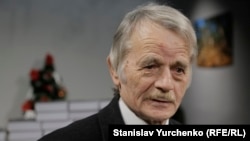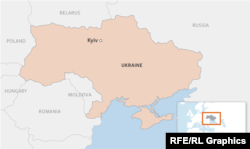An important but widely overlooked demographic transformation has been under way in the Ukrainian region of Crimea since it was annexed by Russia in 2014.
Ukrainian officials and analysts say hundreds of thousands of people from across Russia have been brought into the disputed region in an effort by Moscow to transform the composition of its population.
"Since 2014 there has been a mass movement of people from Siberia," Sergei, who moved to Crimea from St. Petersburg and who blogs under the name Yan Laros, told RFE/RL in March. "At first they went to Krasnodar, but now they have actively begun settling Crimea. Sometimes you get the impression that half of Siberia has suddenly decided to move here."
According to official Russian statistics, some 247,000 Russians have moved to Crimea since annexation. At the same time, about 140,000 people have left, mostly Ukrainians and Crimean Tatars who moved to the Ukrainian mainland.
Ukrainian officials, however, say the real numbers are much greater -- by hundreds of thousands. The population of the peninsula according to the Ukrainian census of 2001 was 2.4 million, of which about 60 percent were ethnic Russians, 24 percent were Ukrainians, and 10 percent were Crimean Tatars. A Russian census in 2014 put the population at 2.285 million, with 65 percent identifying as Russian, 15 percent as Ukrainian, and 12 percent as Crimean Tatar.
"We can say with certainty that we are talking about hundreds of thousands of people," Borys Babin, Ukrainian President Petro Poroshenko's permanent representative on Crimea, told RFE/RL. "An enormous number of bureaucrats are moving in with their families, and those family members are looking for work. In addition, there is a large number of guest workers -- people who come to Crimea for major construction projects that are being carried out in the military sphere."
Babin added that about 40,000 Crimeans registered as displaced persons on mainland Ukraine, adding that tens of thousands more have also left Crimea but have not yet registered as displaced.
Demographic 'War Crime'
On May 27, longtime Crimean Tatar leader Mustafa Dzhemilev, Poroshenko's envoy for Crimean Tatar affairs, gave a shocking interview to Ukrinform in which he estimated the number of people migrating to Crimea from Russia at between 850,000 and 1 million.
"But this is held as a military secret because they know perfectly well that it is a crime," he added, saying that his estimate came from his sources among the Crimean Tatar community still on the peninsula.
"Forcibly shifting the demographic composition of an occupied territory is a war crime under the 1949 Geneva Conventions," Dzhemilev said. "Therefore information about how many people they have brought in is carefully guarded."
Article 49 of the fourth Geneva Convention states that "The Occupying Power shall not deport or transfer parts of its own civilian population into the territory it occupies."
Refat Chubarov, another Crimean Tatar leader who is a deputy in the Ukrainian parliament, said it was impossible to pin down the exact numbers of newcomers arriving from Russia.
"We are talking about military personnel and workers in the security organs, as well as their families," he told RFE/RL. "We are talking about the mass influx of bureaucrats. And a significant number of people have been drawn to Crimea from various regions of Russia thinking that they will live better there."
He noted that several Russian military bases on the peninsula have been created or expanded since the 2014 annexation.
"There is no doubt that the saturation of Crimea with troops and security personnel is being done intentionally with a view to creating a management regime that demands not just loyal, but tested, people," Chubarov added. "These people are selected in Russia."
Andriy Klimenko, editor in chief of the BlackSeaNews website, wrote about the demographic manipulations in June 2017. "The demographic situation in Crimea is viewed by Russia exclusively in the context of forming...a loyal population that is optimized in terms of the cost of maintaining it and is not capable of civic protests or other forms of independent political activity," he wrote.
Carpetbaggers Take Over
Anton Luchezarov says he moved to Crimea from Novosibirsk on his own initiative. "Maybe I am the product of propaganda and did it unconsciously," he quips. "[President Vladimir] Putin is doing a good job."
Likewise, Andrei Novikov came from the central Russian city of Ivanovo to retire in Crimea, which locals say is a common phenomenon. "I considered Thailand, India, Vietnam, and others," he says. "Then the right political moment appeared when Crimea joined Russia and the question of moving abroad was moot. We decided to move to Crimea."
Ukraine and its 44 million people would almost certainly disagree with Novikov's characterization of Russia's land grab -- launched by unmarked troops, buttressed by a dubious referendum under occupation, and effectuated in March 2014, when Putin declared that "Crimea has always been an inseparable part of Russia" -- as "Crimea joining Russia." Weeks later, the UN overwhelmingly rejected Moscow's claim in a declaration on the "territorial integrity of Ukraine."
Analyst Igar Tyshkevich, of the Ukrainian Institute for the Future, says the Russian government has a program aimed at resettling pensioners from the Far North and other regions where it is expensive to maintain them. There are other programs offering incentives to teachers and health-care workers to move to Crimea.
"I worked in medicine for 25 years," says one Sevastopol woman who asks to be identified only as Antonina. "Now only arrivals from Russia are working in medicine. I can understand why they come here -- the sea, and all. But they are pushing out the locals."
In many cases, the influx of Russians has produced tensions and conflicts with the locals, political analyst Yevhen Horyunov says. "[Newcomers] get specific preferences regarding kindergartens and schools," he tells RFE/RL. "This is, everything that Russia can give them to settle in is provided. Meanwhile, local Crimeans stand in line for places in kindergartens and they sometimes even have to turn to the courts to get them."
"I can't even recognize Sevastopol," one local resident who gives her name only as Margarita says. "The government is all newcomers and they aren't very good. They don't even try to find a common language with the locals and are always doing their own thing."
"We need our own people," she concludes, "to run our own city."
History Of Forced Migrations
At a unique geographical crossroads, Crimea has seen similar demographic manipulations many times in the past. In his interview with Ukrinform, Crimean Tatar leader Dzhemilev compared the current situation with what happened after Catherine the Great conquered the region in the 18th century.
"They simply created impossible living conditions for people in order to force them to migrate," he says. "As a result, Crimean Tatars very quickly became a minority people."
Irina Pribytkova, a sociologist with the Ukrainian Academy of Sciences, notes that after Soviet dictator Josef Stalin forcibly deported the Crimean Tatars and other ethnic groups from the peninsula in 1944, the Soviet government brought in ethnic Russian collective farmers from across Russia.
"After [the collapse of the Soviet Union], a large number of Crimean Tatars, Armenians, Bulgarians, Greeks, and others took advantage of the liberal political situation to return to Crimea," Pribytkova says. "Now something similar is being played out, only this time with Russians."
"Since 2014, I think, it is possible to talk about the intentional replacement of the population," she adds.
"A demographic process is under way," Pribytkova says, "and it needs to be included in the constant monitoring that Ukraine carries out in order to understand the results of these changes. Crimean Tatars will be constantly provoked so that they leave Crimea or accept Russian citizenship. The disobedient will be imprisoned with the goal of intimidating the others."
















